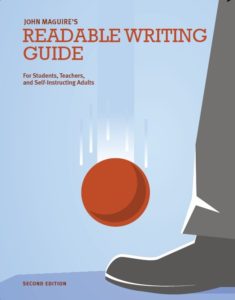Thank you for being open to an email exchange.
I’ve seen references to your Jump method for a few years, and my wife has kept repeating, “This guy’s done for math what you’ve done for writing,” and finally I used LinkedIn to reach you.
My library of learning has included some of the classics, and some little known books on training, especially “Don’t Shoot the Dog” by Karen Pryor. (https://www.amazon.com/dp/0553380397?tag=duckduckgo-ffnt-20&linkCode=osi&th=1&psc=1)
If you don’t know Pryor’s book, especially the first edition, you are missing a treat. She is an animal trainer (dogs, horses, dolphins, whales, chickens, children—anything). She has a masterful understanding of the principles of training and she writes like Hemingway. As I said, a treat.
From her I learned a set of ideas that transformed my teaching. I’m going to use the word animal to mean student here:
“Pick something the animal can do without effort, reinforce it, shape it in small steps toward the final behavior you want; do not punish; the learning itself is significant reward; at some point the animal will grasp the point of the learning and will move ahead as rapidly as possible; stop a training session before the animal is exhausted. Add behaviors one at a time. Reinforce for one behavior at a time, but build compound behaviors so a compound behavior becomes a single behavior, and reinforce for that. Never reinforce for two behaviors at once because it will confuse the animal. If the animal is progressing slowly, you have broken the skill down the wrong way. To correct bad habits, train the desired habit afresh from a different starting point.”
That paragraph is in quotes, but it’s my paraphrasing of Pryor’s viewpoint. I have used most of those ideas in my course, and students learn to write quickly for me.
My method is consciously constructed. I haven’t got a lot of time today, but to summarize, I constructed the method from these materials:
- Pryor’s understanding of training. The reinforcement of small steps that aim for a final complex performance. Writing is a behavior and one can be trained effectively or ineffectively in it.
- Rudolf Flesch’s The Art of Readable Writing. He’s the giant who did readability studies of textbooks and by reverse engineering was able to explain how to write clearly for the reader.
- Hayakawa and Korzybski’s “ladder of abstraction” from their general semantics writing in the 1930s.
- Strunk & White.
In good writing, you are doing a number of things at once. It’s a compound skill—which makes it so hard to teach. But if you break the skill down properly, you can get rapid progress. As you might guess, I have broken writing skill down in an unconventional way, so naturally I teach different things than most teachers. I take students up the mountain of writing skills–as all teachers do–but I take a different trail to the peak.
This video is the best short summary of the first part of my course. https://readablewriting.com/five-keys-to-readability/
Nice to be talking to the Master of Jump Math!
John

